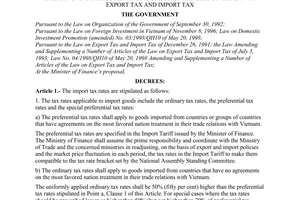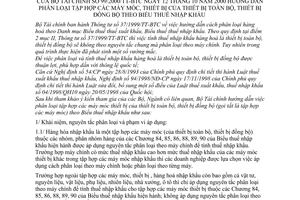Nội dung toàn văn Circular No. 99/2000/TT-BTC of October 12, 2000 guiding the classification of groups of machinery and equipment units of complete equipment and synchronized equipment according to the import tariff
|
THE MINISTRY OF FINANCE |
SOCIALIST REPUBLIC OF VIET NAM |
|
No: 99/2000/TT-BTC |
Hanoi, October 12, 2000 |
CIRCULAR
GUIDING THE CLASSIFICATION OF GROUPS OF MACHINERY AND EQUIPMENT UNITS OF COMPLETE EQUIPMENT AND SYNCHRONIZED EQUIPMENT ACCORDING TO THE IMPORT TARIFF
The Ministry of Finance issued Circular No. 37/1999/TT-BTC of April 7, 1999 guiding the method of goods classification according to the lists of Export Tariff and Import Tariff. According to the provisions at Point 2, Section II of Circular No. 37/1999/TT-BTC the calculation of import tax on goods being complete equipment or synchronized equipment shall not comply with the general principles, but they are classified according to the main unit. However, some problems have arisen in the course of implementation.
In order to make the classification and calculation of import tax on goods being complete equipment and synchronized equipment more convenient and gradually comfortable to international practices;
Pursuant to the Government’s Decree No. 54/CP of August 28, 1993 detailing the implementation of the Law on Export Tax and Import Tax, Decree No. 94/1998/ND-CP of November 17, 1998 detailing the implementation of Law No. 04/1998/QH10 of May 20, 1998 amending and supplementing a number of articles of the Law on Export Tax and Import Tax;
After consulting with the concerned ministries and branches, the Finance Ministry hereby guides the classification of groups of machinery and equipment units of complete equipment and synchronized equipment (called the groups of machinery for short) according to the Import Tariff as follows:
1. Classification definition, principles and application scope:
1.1. Import goods being a group of machinery units under headings or subheadings in Chapters 84, 85, 86, 88, 89 and 90 of the current Import Tariff shall be entitled to the application of the principle of classification according to the main unit for import tax calculation. In cases where the main unit’s import tax rate is higher than those of other machinery and equipment in the group of import machinery, the concerned enterprise may opt for the application of the method of classification either according to the main unit or to each unit.
In cases where the import goods also include supplies, raw materials, materials, auxiliary materials, fuel, workshops and automobiles besides groups of machinery and equipment, only the principle of classification according to the main unit for import tax calculation for the groups of machinery and equipment in Chapters 84, 85, 86, 88, 89 and 90 of the current Import Tariff shall apply; not to apply this principle to import goods being supplies, raw materials, materials, auxiliary materials, fuel, workshops and automobiles (these commodities shall comply with the following principle: they shall be classified according to the codes prescribed for them in the current Import Tariff).
1.2. A group of machinery entitled to the application of the principle of classification according to the main unit shall include at least two units of machinery or equipment of one or more headings or subheadings in Chapters 84, 85, 86, 88, 89 and 90 in the current Import Tariff. This group may be either a combination (For example: a combination of television machinery and equipment includes recording equipment, transmission equipment, camera,...; a cigarette-producing combination includes cigarette-leaves processor, cigarette-rolling machine, packing equipment,...) or a production chain (For example: a tailoring chain includes sewing machines, interlockers, button-holing machine, button-sewing machine, designing machine, sewing table, cutting machines, generator,...). Different machinery units of this group are inter-supportive, inter-linked so as to simultaneously or consecutively perform separate functions of each machine and the whole system.
1.3. The group of machinery entitled to the application of the principle of classification according to the main unit mentioned at Points 1.1 and 1.2 may:
1.3.1. Be imported from one or more markets, with origins from one or more regions or countries, be imported in one or different shipments but the group of imported machinery and equipment shall create a combination or a chain of a series of machinery and equipment, which are inter-supportive and inter-linked so as to simultaneously or consecutively perform separate functions of each machine and the whole system.
1.3.2. Be both imported and self-made or purchased in the country but they shall have to meet 3 following conditions:
- The main unit must be imported;
- The group of machinery and equipment both imported and self-made or purchased in the country constitutes a combination or a chain of a series of machinery and equipment, which are inter-linked and inter-supportive so as to simultaneously or consecutively perform separate functions of each machine and the whole system;
- Subjects using groups of machinery both imported and self-made or purchasing home-made machinery shall have to declare by themselves and be responsible before law for such self-made or home-made machinery, the name of machine manufacturers or suppliers and be responsible before law for such declaration. In case of false declaration, apart from the retrospective collection of import tax according to the code of each machinery and equipment prescribed in the current Import Tariff, they may be administratively sanctioned or examined for penal liability under the current provisions of the Law on Export Tax and Import Tax and relevant documents.
2. Procedures and dossiers for the classification and import tax calculation according to the main unit:
2.1. Economic-technical feasibility study or investment project on complete equipment or synchronized equipment approved by the competent body, clearly stating the name of machinery and equipment imported, domestically produced or purchased.
2.2. The specialized managing body of the unit using complete equipment or synchronized equipment shall certify the main unit of the group of imported machinery and be responsible before law for its certification’s authenticity. For example: The Ministry of Industry shall be the body which certifies the main unit of the synchronized equipment of the textile and garment production chain; the Ministry of Agriculture and Rural Development shall be the body which certifies the main unit of complete equipment of vegetable and fruit canneries.
If any problems arise in the certification of the main unit, the specialized managing body shall consult with the Finance Ministry and the concerned ministries or branches in order to determine the main unit serving as basis for calculation of import tax on these machinery and equipment.
2.3. Import contracts (direct or consignment), the packing list and other vouchers (if any) clearly stating the names of imported machinery and equipment.
3. Implementation organization
3.1. Basing themselves on the dossiers prescribed at Point 2 and the results of inspection of goods actually imported, or both imported and self-made or purchased in the country (if any), in accordance with the provisions at Point 1 of this Circular, the customs offices where import procedures are carried out shall calculate tax on the groups of machinery of the complete equipment or synchronized equipment according to the main unit, which have been certified by the using units’ specialized managing bodies, and open books for monitoring the actually imported goods in compliance with the lists of goods to be imported, already approved by the bodies which have approved the economic-technical feasibility study or investment projects. The goods not on the list of those to be imported, which have already been approved by the economic-technical feasibility study or investment project-approving bodies, must be classified and subject to the calculation of import tax rates for them.
3.2. In case of any doubt about inaccurate certification of the main unit, the customs offices where import procedures are carried out shall still temporarily calculate tax according to the already certified main unit and promptly report the case to the certifying body and, at the same time, to the General Department of Customs for settlement. If problems remain, the General Department of Customs shall coordinate with the Finance Ministry and the concerned ministries or branches in finding out measures for timely handling.
If the customs office’s detection is correct, the tax on the imported goods shall be re-calculated. If the already paid import tax amount is larger than the payable tax amount according to the re-calculated tax level, the difference shall be returned to the machinery-using unit or deducted against the tax amount to be paid on the next goods lot. If the already paid tax amount is smaller than the payable tax amount according to the re-calculated tax level, the customs office shall retrospectively collect the tax.
The tax retrospective collection, reimbursement or deduction shall comply with the provisions of the Law on Export Tax and Import Tax and the documents amending, supplementing or guiding the implementation of the Law on Export Tax and Import Tax.
3.3. For cases where the declaration of importation of the groups of machinery of synchronized equipment or complete equipment is made for calculation and payment of import tax according to the main unit, while in fact such machinery and equipment are not used in a combination or a production chain, but separately, such declaring unit, apart from the retrospective collection of import tax at the import tax rate prescribed for each machine, shall be administratively handled or examined for penal liability under the current provisions of the Law on Export Tax and Import Tax and relevant documents.
3.4. The Finance Ministry shall coordinate with the concerned ministries or branches in handling the application of the principle of classification according to the main unit to cases of importing groups of machinery of complete equipment or synchronized equipment with not only machinery and equipment of headings or subheadings in Chapters 84, 85, 86, 88, 89 and 90 but also those of other chapters in the current Import Tariff (For example: complete equipment of gas pipelines).
3.5. This Circular guides the method of classification of import goods being groups of machinery of complete equipment or synchronized equipment, takes effect from November 1st, 2000 to the end of December 31st, 2001 (as from January 1st, 2002, the classification shall comply with the principles of the List of export and import goods of the World Customs Cooperation Council), replaces Point 2, Section II, Part A - The goods classification principles of the Import Tariff guided in Circular No. 37/1999/TT-BTC of April 7, 1999 guiding the goods classification method according to the lists of Export Tariff and Import Tariff and the Finance Ministry’s Official Dispatch No. 5262/TC-TCT of October 19, 1999 on handling of import tax on complete equipment and synchronized equipment.
3.6. The groups of machinery and equipment under headings and subheadings in Chapters 84, 85, 86, 88, 89 and 90 in the current Import Tariff, if entitled to the application of the principle of classification according to the main unit for import tax calculation as prescribed in this Circular, shall also be considered the synchronized equipment to serve as basis for deter-mining the objects not liable to value added tax (VAT) under the provisions of the Value Added Tax Law.
3.7. If any problems arise before the effective date of this Circular and in the course of implementation of this Circular, the units are requested to report them to the Finance Ministry for settlement on the case-by-case basis.
|
|
FOR THE FINANCE MINISTER |



